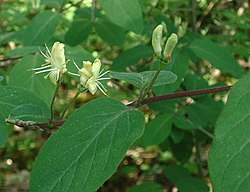| Lonicera xylosteum | |
|---|---|
 | |
| Scientific classification | |
| Kingdom: | Plantae |
| Clade: | Tracheophytes |
| Clade: | Angiosperms |
| Clade: | Eudicots |
| Clade: | Asterids |
| Order: | Dipsacales |
| Family: | Caprifoliaceae |
| Genus: | Lonicera |
| Species: | L. xylosteum |
| Binomial name | |
| Lonicera xylosteum | |

Lonicera xylosteum, commonly known as fly honeysuckle, [1] European fly honeysuckle, dwarf honeysuckle [2] or fly woodbine is a deciduous shrub. [1]
Its fruit persists for an average of 15.4 days, and bears an average of 4.5 seeds per fruit. Fruits average 88.6% water, and their dry weight includes 43.4% carbohydrates and 1.2% lipids. [3]
The glossy red (or occasionally yellow) berries of this shrub are mildly poisonous to humans – children who ingest a large number (c. 30) of berries may experience abdominal pain and vomiting. [4]